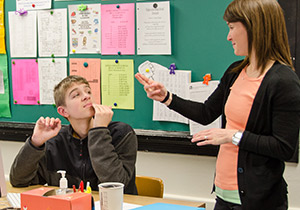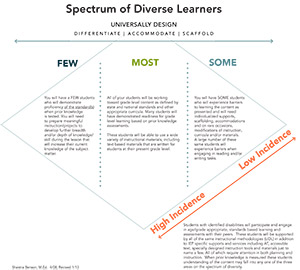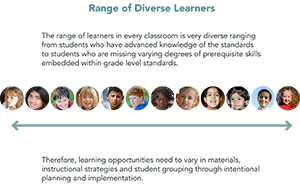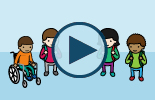Teaching All Learners Overview
Given the diversity of students in classrooms today, teachers are challenged with ensuring that each and every student is able to access standards based instruction and assessment. Many instructional methods and strategies are effective for a significant number of students across the content areas, but teachers are often faced with finding additional student specific tools and strategies that address the unique needs of some students enrolled in their classes. Universal Design for Learning, differentiated instruction, collaborative planning, technologies and IEP specific supports and services should be included throughout planning practices to ensure access and inclusive opportunity for ALL learners.
In today's widely diverse classrooms teacher teams are taking on the ever-challenging task of planning for instruction and assessment. While the majority of students are ready to progress forward on grade level standards, shown here as the middle section of the diamond which represents grade level readiness, we also have students that fall outside of the majority with higher or lower levels of skill and understanding of the targeted standard. Planning, instruction and assessment must consider and prepare for all 3 groups. It is imperative that the target standard not be compromises or watered down but that students progress through skills leading to the standard and that all students have access to accommodations and technologies that reduce unnecessary barriers to the standard. All too often we plan and teach to the middle leaving some of our students behind. The key is to offer more flexibility in instructional methods and materials within general, Tier I, instruction by planning for access and participation based on the unique needs of our learners prior to their inability to complete tasks successfully. Pre-planning for flexible options in tools, instruction and assessments is detailed further throughout the use of Universal Design for Learning.
Imagine the faces of all of your students across the range of readiness and understanding of a given standard that is targeted for both instruction and assessment. The range of understanding runs from advanced knowledge beyond the standard to missing prerequisite skills associated with the standard.
This range of photos offers a snapshot into a classroom where we see individuals who have varied needs, knowledge and abilities. What is our role as an educator, service provider, and family in preparing these learners for their futures?

English Language Learners
Ohio's English Language Learners (ELL) represent a variety of home/native languages, cultural backgrounds and levels of English proficiency. They may be refugees, or U.S born, and they may have extensive formal school experiences or little/no prior schooling. Although ELLs have limited English proficiency, their native/home language skills and cultural experiences can be useful assets in their learning process.
When teachers are aware of the background, needs and strengths of their students, and have an understanding of strategies and resources under the UDL framework, they can work together to help their ELLs access Ohio's revised standards.
View of Ohio Department of Education's English Language Learners
Students with Disabilities

Students in Ohio can be identified with one of 13 different disability classifications. Low incidence disabilities are represented in several of these 13 classifications including blindness, low vision, deafness, hard-of-hearing, deaf-blindness, significant developmental delay, complex health issues, serious physical/orthopedic impairment, multiple disability and autism. Disabilities listed under low-incidence disabilities generally represent no more than 1% of the school-aged population at any given time. A significant amount of diversity, exists both within and between each of these disability categories.
Students with disabilities can achieve at high levels when provided with instructional supports and accommodations, and when educated with students without disabilities to the maximum extent possible.
UDL enables teachers to plan instruction for a wide range of learners. For example, a teacher may customize the display of information for a student with a visual impairment, or allow a student with a specific disability to express knowledge through the use of multiple media.

Gifted and Talented
Ohio law establishes criteria for students to be identified as gifted in the areas of academic achievement, cognitive abilities, creative thinking and/or visual/performing arts. Gifted students may be served in the regular classroom through differentiation and/or in classes with other gifted students taught by a gifted intervention specialist. For gifted students, UDL helps to frame the differentiation that needs to take place in all academic settings in the area of the student's identification.


